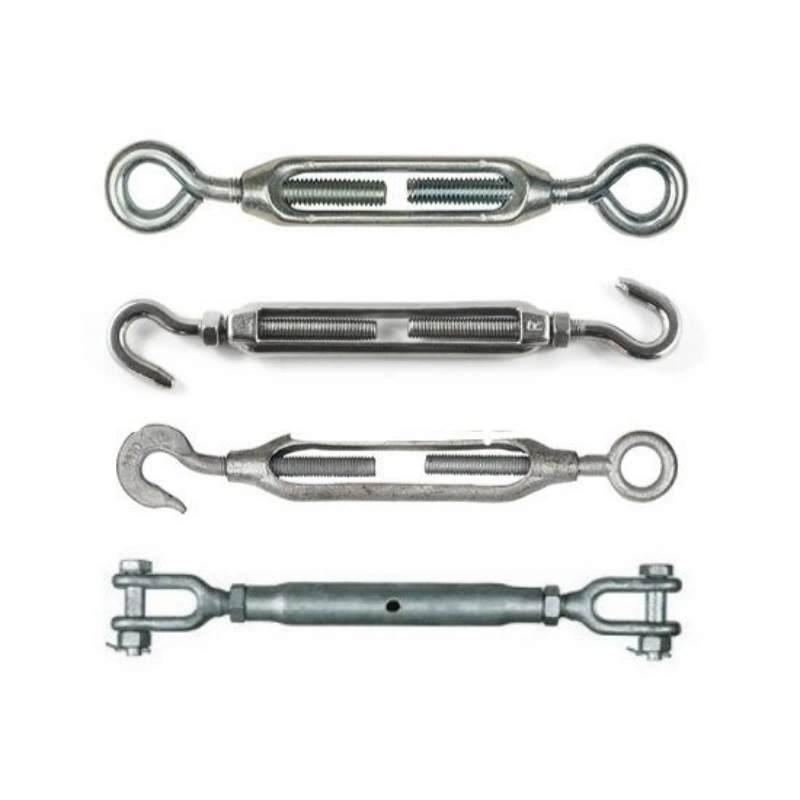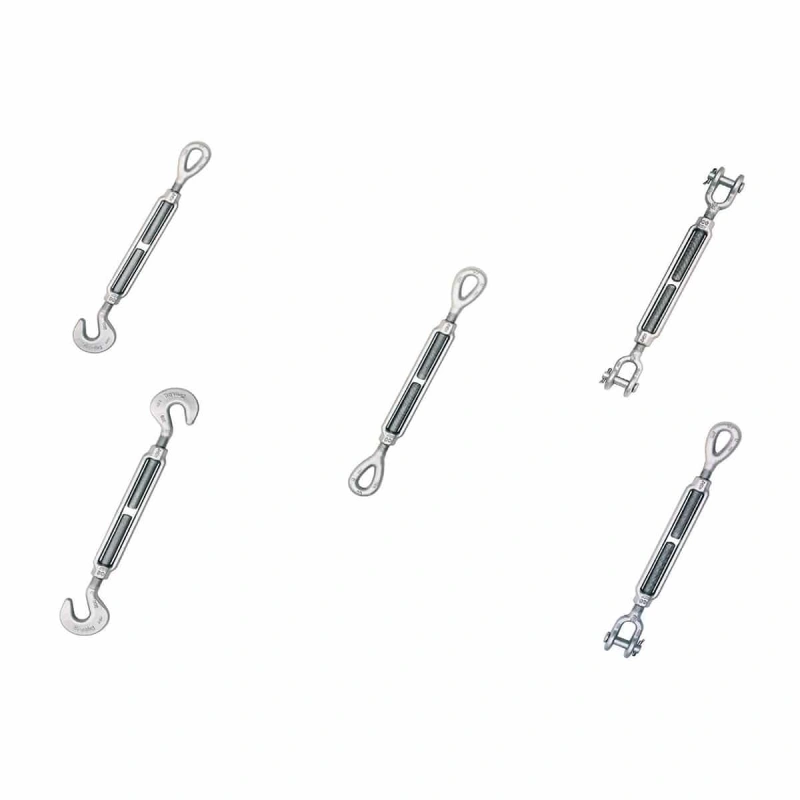You use a turnbuckle by attaching each end to your cables, ropes, or rods and rotating the central body to adjust tension. This process helps you achieve precise control for securing loads or supporting structures. Turnbuckles play a critical role in industries where safety and reliability matter most.
Industry | Application Description |
|---|---|
Construction | Tensioning cables, supporting scaffolding, and ensuring structural integrity of bridges, towers, and buildings. |
Shipping & Marine | Rigging, securing cargo, and maintaining the stability of vessels. |
Aerospace & Defense | Precision and reliability in aircraft assembly, maintenance, and ground support equipment. |
Oil & Gas | Pipeline support, rigging, equipment stabilization, focusing on safety and efficiency. |
Utilities | Installation and maintenance of transmission lines and substations, with emphasis on renewable energy. |
Entertainment | Setting up stages, lighting rigs, and temporary structures for live events. |
Others | Specialized applications in mining, agriculture, and transportation. |
If you’re wondering how to use a turnbuckle, remember that it is essential for achieving the right tension in various applications across these industries.
Key Takeaways
Turnbuckles adjust tension in cables, ropes, or rods, ensuring safety and stability in various applications.
Always inspect turnbuckles before use to identify wear or damage, which helps maintain safety and reliability.
Select the right type of turnbuckle based on your project needs, considering load capacity and environmental conditions.
Adjust tension gradually and evenly to avoid over-tightening, which can damage the rigging system.
Secure all connections with lock nuts or safety wire to prevent loosening during operation.
What Is a Turnbuckle?
Definition
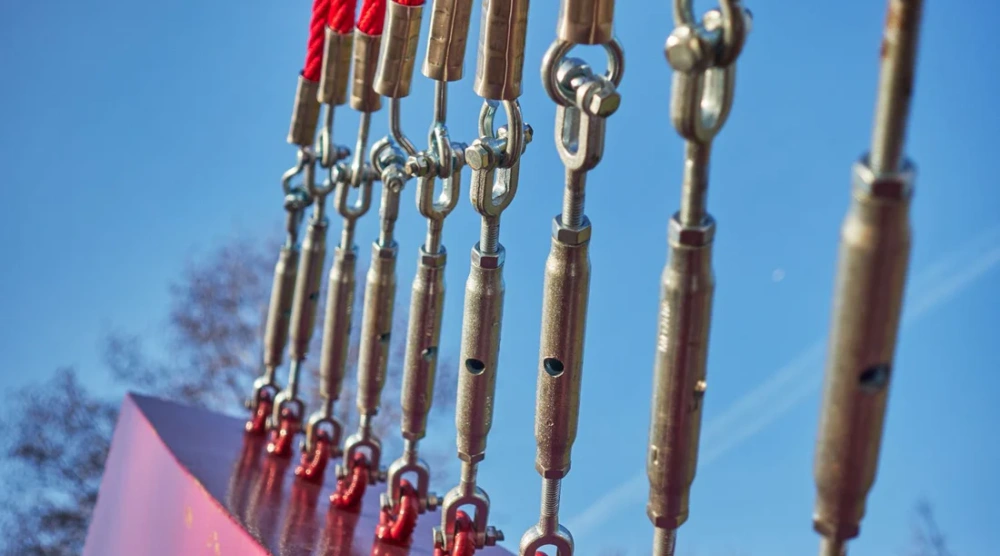
A turnbuckle is a mechanical device that allows you to adjust the tension or length of cables, ropes, or rods with precision. You will find a central metal body with threaded ends, usually featuring hooks, eyes, or jaws. By rotating the body, you can draw the ends closer together or push them apart.
This simple tool gives you control over tension in a wide range of applications. You can use turnbuckles in construction, marine, entertainment, and industrial settings. The design makes it easy for you to achieve the exact tension needed for safety and stability.
Tip: When you select a turnbuckle, always check the material and threading type. Stainless steel models offer superior corrosion resistance, especially in outdoor or marine environments.
Main Functions
Turnbuckles serve several essential functions in rigging and tensioning systems. You rely on them for tasks that demand accuracy and reliability. Here are the primary roles a turnbuckle plays:
You adjust tension in cables and wires, which helps maintain structural integrity in buildings and bridges.
You stabilize poles and towers by providing tension in guy wires during construction projects.
You fine-tune rigging tension for sails on boats, improving both performance and safety in marine environments.
You maintain tension in fencing for agricultural and residential use, ensuring the fence remains effective over time.
You set up and secure rigging in the entertainment industry, such as for stages and lighting, which enhances safety and flexibility.
Turnbuckles give you the ability to make quick, precise adjustments. You can easily tighten or loosen connections without dismantling the entire system. This versatility makes turnbuckles a vital component in any project where tension control is critical.
Types of Turnbuckles
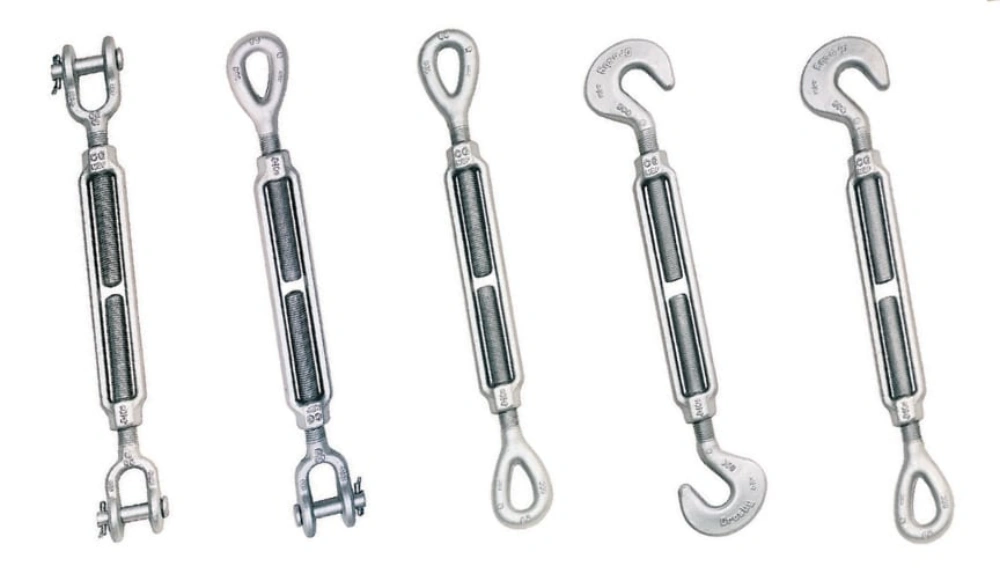
Powerful Machinery stands out as a trusted provider of certified turnbuckles and rigging hardware. You can rely on their products for strength, safety, and compliance with international standards such as DIN 1480, JIS, ASTM, and ISO.
When you choose a turnbuckle, you should consider the type, material, and application to ensure the best performance.
Note: Turnbuckles are classified by body style, end fittings, and materials. The right choice depends on your project’s environment and load requirements.
Type | Description | Common Materials |
|---|---|---|
Open-Body | Exposed body for easy inspection; used in construction and rigging. | Stainless steel, galvanized steel |
Closed-Body | Fully enclosed design; suitable for harsh environments like marine use. | High-strength aluminum alloys |
Swage | Designed for high strength and aesthetics; used in architectural projects. | High-grade stainless steel |
Jaw Swage Turnbuckle
You use the Jaw Swage Turnbuckle when you need a secure, permanent connection. This type features a jaw end with a clevis and pin, which gives you a strong attachment point.
Powerful Machinery’s stainless steel jaw swage turnbuckles resist corrosion, making them ideal for marine, architectural, and structural rigging. You can trust these for projects that demand both durability and a polished appearance.
Feature | Description |
|---|---|
Jaw End | Clevis and pin for secure, permanent attachment |
Material | Marine-grade stainless steel (AISI 316) |
Applications | Marine rigging, shade structures, wire balustrades, architecture |
Toggle Turnbuckle
Toggle turnbuckles give you flexibility and easy tension adjustment. You benefit from a pivoting toggle end, which allows movement and reduces stress on cables.
Powerful Machinery manufactures these from 316 stainless steel, so you get excellent corrosion resistance for marine and architectural uses. You should select toggle turnbuckles for wire railings, shipbuilding, or landscaping projects.
Material | Description | Best For |
|---|---|---|
Stainless Steel | Highly corrosion-resistant, long-lasting | Marine, harsh weather, saltwater |
Jaw to Jaw Turnbuckle
You choose a Jaw-to-Jaw Turnbuckle for high-tension or heavy-duty applications. Both ends have jaws with clevis pins, which provide a stable and secure connection. Powerful Machinery offers these in 304 or 316 stainless steel, ensuring strength and resistance to harsh environments.
You will find them useful in marine, industrial, and construction settings where safety is critical.
Product Name | Load Capacity | Material |
|---|---|---|
US Type Jaw to Jaw Turnbuckle | Heavy Duty | 304/316 Stainless |
Hot Dipped Galvanized Steel Jaw & Jaw | 3500 lbs | Galvanized Steel |
Hook and Hook Turnbuckle
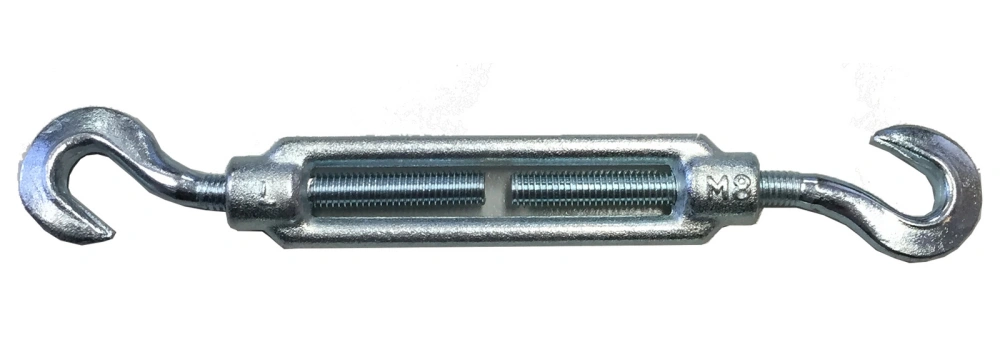
You use Hook and Hook Turnbuckles when you need quick, tool-free connections. The hook ends allow you to attach and detach cables or ropes easily, which is perfect for temporary setups or frequent adjustments.
Powerful Machinery’s hook and hook turnbuckles are made from stainless steel for durability and corrosion resistance. You should use these in dynamic environments like event rigging or temporary fencing.
Tip: The hook design makes tensioning fast, but for permanent or high-security connections, consider jaw or eye fittings.
Hook Eye Turnbuckle
You select a Hook Eye Turnbuckle for outdoor and marine applications. The hook end provides easy attachment, while the eye end ensures a secure connection.
Powerful Machinery’s stainless steel hook eye turnbuckles excel in coastal and humid environments due to their corrosion-resistant finish. You can use them to tighten cables on boats, secure outdoor structures, or manage tension in rigging projects.
Stainless steel construction resists saltwater and weather.
Designed for outdoor, marine, and industrial use.
Ideal for managing tension in fencing, rigging, and suspension systems.
Reminder: Always check for international certifications and material grade to ensure safety and compliance in your projects.
How Do You Use a Turnbuckle?
When you want to achieve precise tension in your rigging system, you need to follow a systematic process. Whether you are working with Powerful Machinery’s stainless steel jaw swage turnbuckles, toggle turnbuckles, or other certified models, the steps remain consistent.
Here’s how to use a turnbuckle safely and effectively:
Inspection
Before you install any turnbuckle, you must inspect it thoroughly. This step ensures safety and reliability in your rigging system. Use the following table to guide your inspection routine:
Inspection Type | Description |
|---|---|
Initial Inspection | Verify compliance for new, altered, modified, or repaired hardware before use. |
Frequent Inspection | Conduct a visual inspection each shift before use; remove from service if any hazards are identified. |
Periodic Inspection | Complete inspection at least once a year; frequency based on usage and service conditions. |
You should also check the entire rigging system, not just the turnbuckle. Look for signs of wear, corrosion, or deformation on cables, rods, and fittings. If you notice any damaged parts, replace them immediately.
Powerful Machinery’s products are designed for durability, but regular inspections help you maintain optimal performance.
Tip: Always inspect clevis pins, cotter pins, and toggles for secure installation. Grease the threads of your turnbuckle to prevent seizing and extend its lifespan.
Attachment
Proper attachment is critical for a secure and stable connection. When you attach a turnbuckle to cables or rods, select the right type based on load limit, material, cable size, corrosion resistance, thread size, and tensile strength. This ensures compatibility and safety in your application.
Start by choosing the correct Powerful Machinery turnbuckle for your project. For example, use a jaw swage turnbuckle for permanent marine rigging or a hook and hook turnbuckle for temporary event setups.
Attach each end fitting to the corresponding anchor point, cable, or rod. Make sure the fittings match the hardware and that the anchor points are solid and capable of handling the expected tension.
Note: Double-check the installation of clevis pins and cotter pins. Improperly secured pins can lead to disconnections, especially in high-stress environments.
Adjustment
Once you have attached the turnbuckle, you need to adjust it to achieve the desired tension. Here’s a step-by-step guide on how do you use a turnbuckle for optimal tensioning:
Unscrew both end fittings from the turnbuckle body until they are fully extended.
Attach one end to the anchor point or fixed structure.
Extend the other end of the cable or rod and secure it.
Rotate the central body of the turnbuckle to draw the ends closer together. Increase tension slowly and evenly.
If your turnbuckle includes lock nuts, tighten them against the body to secure the adjustment.
You should avoid over-tightening, as this can damage the rigging or the turnbuckle itself. Check that the tension is even across the system. For applications like wire balustrades or marine rigging, Powerful Machinery’s stainless steel models provide smooth adjustment and reliable holding power.
Pro Tip: After tensioning, inspect the alignment of the turnbuckle. It should be in a straight line with the load to prevent side loading, which can cause failure.
Securing
After you have adjusted the turnbuckle, you must secure it to prevent loosening during operation. Follow these best practices:
Always use turnbuckles in straight pull, in-line applications.
Never use turnbuckles in side load situations.
Ensure all anchor points are solid and can withstand the applied tension.
Tighten lock nuts or use safety wire to prevent the turnbuckle from rotating under vibration or load.
For jaw-type turnbuckles, confirm that clevis pins and cotter pins are properly installed and locked.
Regular maintenance checks are essential. Grease the threads periodically and inspect for signs of wear or corrosion. Replace any worn toggles or hardware to maintain even stress distribution.
Common Mistakes to Avoid:
Neglecting to inspect the entire rigging system before installation.
Using incompatible components that may cause corrosion or failure.
Forgetting to adjust tension after fitting new turnbuckles.
Skipping regular maintenance and lubrication.
By following these steps, you will answer the question of how to use a turnbuckle with confidence. You ensure safety, reliability, and long-term performance in every application, whether you work in construction, marine, or industrial environments.
Safety Tips
Inspection and Maintenance
You must inspect your turnbuckles before each use. This step helps you identify wear, corrosion, or physical damage that could compromise safety. The Occupational Safety and Health Administration (OSHA) states:
The Occupational Safety and Health Administration (OSHA) says that equipment should be ‘inspected before use on each shift and as necessary during its use to ensure that it is safe.’ If the equipment is damaged in any way, it should be withdrawn from service immediately.
You should follow a routine that includes these essential practices:
Conduct regular inspections before every use to check for wear, corrosion, or physical damage.
Clean turnbuckles frequently to remove dirt and corrosive substances.
Lubricate threads and moving parts to reduce friction and prevent rust.
Apply anti-rust sprays or grease in harsh environments.
Test the load capacity if you notice any wear or damage.
Replace any turnbuckle that shows significant corrosion or wear.
Keep records of all inspections and maintenance activities.
For heavy-duty or harsh environments, you need to increase inspection frequency. OSHA and ASME recommend periodic inspections every twelve months, but you may need to inspect quarterly or monthly in demanding conditions.
Proper Use
You must use turnbuckles according to manufacturer guidelines and safety standards. Powerful Machinery’s turnbuckles meet top certifications, including ISO9001, TUV, OSHA, and DNV. These certifications guarantee strict quality control and reliable safety features.
Manufacturer | Safety Certifications | Key Safety Features |
|---|---|---|
Powerful Machinery | ISO9001, TUV, OSHA, DNV | Electric galvanized finish, strict QC, custom options |
You should always:
Select the correct turnbuckle type for your application.
Avoid side loading and ensure straight pull alignment.
Secure all pins, nuts, and locking mechanisms before applying tension.
Never exceed the rated load capacity.
Replace damaged or worn components immediately.
Training resources, such as this guide and instructional videos, help you master installation and safe usage. You can answer how to use a turnbuckle safely by following these steps and using certified products.
Tip: Proper training and regular maintenance protect you and your equipment from unexpected failures.
Conclusion
You can use turnbuckles safely and effectively by following these steps:
Inspect all components before use.
Attach each end securely to the correct anchor points.
Adjust tension gradually and evenly.
Secure all pins and locking mechanisms.
When selecting a certified, high-quality turnbuckle, you should:
Understand your project requirements.
Choose the appropriate type, such as jaw, hook, or eye.
Ensure the product meets safety standards.
Industry | Critical Application Example |
|---|---|
Nautical | Rigging systems on boats |
Construction | Suspension bridges and scaffolding |
Industrial | Load balancing in cranes and conveyor belts |
Mining | Withstanding harsh, vibrating environments |
Using certified turnbuckles from trusted suppliers like Powerful Machinery improves safety and reduces long-term costs. If you ever wonder how to use a turnbuckle for complex projects, consult an expert. Reliable turnbuckles help you achieve success in every application.
FAQ
How do you choose the right turnbuckle for your project?
You should match the turnbuckle’s load rating, material, and end fittings to your application. Always check the cable or rod size and environmental conditions. Stainless steel works best for marine or outdoor use.
How do you prevent a turnbuckle from loosening during use?
You can secure the turnbuckle by tightening lock nuts or using safety wire. Always check that all pins and locking mechanisms are in place before applying tension.
Can you reuse turnbuckles after disassembly?
Yes, you can reuse turnbuckles if you inspect them for wear, corrosion, or thread damage. Replace any worn or damaged parts before reinstalling.
What is the best way to maintain your turnbuckles?
Clean and lubricate the threads regularly. Inspect for rust or deformation. Store turnbuckles in a dry place when not in use. Replace any component that shows signs of excessive wear.
How tight should you make a turnbuckle?
Tighten the turnbuckle until the cable or rod feels firm and secure. Avoid over-tightening, which can damage the hardware or the system. Always follow the manufacturer’s recommended tension limits.

